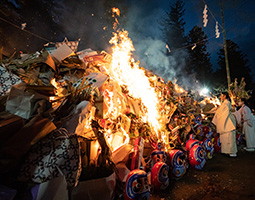February 2023
- English
- 日本語
The Burning of New Year’s Decorations

Dondo-yaki, the burning of new year’s decorations, at Oosaki Hachimangu Shrine 
Hadaka-mairi, the “naked” shrine visit, at Oosaki Hachimangu Shrine

Aerial view of the gojinka 
The gojinka, or sacred bonfire

The Matsutaki Matsuri (Pine Burning Festival) at Oosaki Hachimangu Shrine in Sendai City, Miyagi Prefecture is a festival at which new year’s decorations are ritually burned on a large scale.

The start of the new year is called shogatsu in Japan, and since ancient times, it has been a period for households to welcome in Toshigami-sama, the deity of the new year who brings happiness in such forms as bountiful harvests and the promise of many descendants.
It is believed that Toshigami-sama comes down from a high mountain at the start of the year, so people across Japan clean their homes at the end of December in the hope that the deity will visit. There are also customs to display special decorations for the new year. Placed near the entrance to the home are kadomatsu ornaments made from pine or bamboo and shimenawa ropes made by twisting rice straw, which indicate that the home is pure and a suitable place for Toshigami-sama to visit. These new year’s decorations are then collected in temple and shrine precincts, and next to rivers, and burned on koshogatsu, or “little new year”*, on the set date of January 15 in many areas. In some areas, the fire and smoke rising up from the fires is a send-off for Toshigami-sama as he returns to the high mountain, and in some regions, it is held as a sacred event known as dondo-yaki (burning of new year’s decorations).
Oosaki Hachimangu Shrine was built in Sendai, Miyagi Prefecture, in 1607, and the Matsutaki Matsuri (“Pine Burning Festival”) held there is a sacred event in which new year’s decorations are ceremonially burned. Local people refer to these large-scale events in Sendai as Donto-sai.

Oosaki Hachimangu Shrine’s Matsutaki Matsuri usually begins at sunset on January 14. “The fire meant to return Toshigami-sama back to the heavens is called gojinka, or sacred bonfire. If you come in contact with the smoke, it is said that you will enjoy sound health. We also pray for business prosperity and family safety,” says Onome Inami, the negi, or senior priest, at Oosaki Hachimangu Shrine.
At dusk, when the new year’s decorations, ornaments and amulets entrusted to the temple and piled up some five meters high burst into flames, the smoke rises high into the heavens creating a mystical scene. Shrine visitors approach the fire with the new year’s decorations, ornaments and amulets that they have brought with them and throw them in to the flames. This sacred bonfire for sending off Toshigami-sama burns continuously for two or three days. Before the coronavirus outbreak, some 100,000 visitors would visit the shrine during this period.
One important event held during the Matsutaki Matsuri at Oosaki Hachimangu Shrine is the hadaka-mairi (naked shrine visit), in which thousands of near-naked men brave the freezing cold night to visit the shrine. The men hold bells in their right hand and lanterns in their left. This hadaka-mairi traces its roots back to the Edo period (early seventeenth century to mid-late nineteenth century) and a midwinter ceremony when toji** sake brewers prayed for good health and prosperity in business.

These days everyone is able to participate in the hadaka-mairi including women, who wear upper garments and other clothes over the traditional attire for the naked festival. Priest Onome explains, “The festival may look different depending on the times, but the spirit of the worshippers and the act of praying remain the same. If you visit during the festival, I think you will feel awed by the mystique of the blazing flames and sense the purifying and healing power that the flames hold.”
* A new year’s event centered around January 15. January 1 is called ooshogatsu, or “big new year.”
** A toji is the head brewer responsible for managing the sake brewing process.

